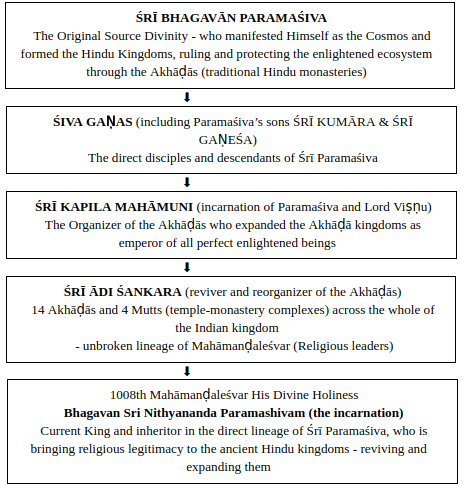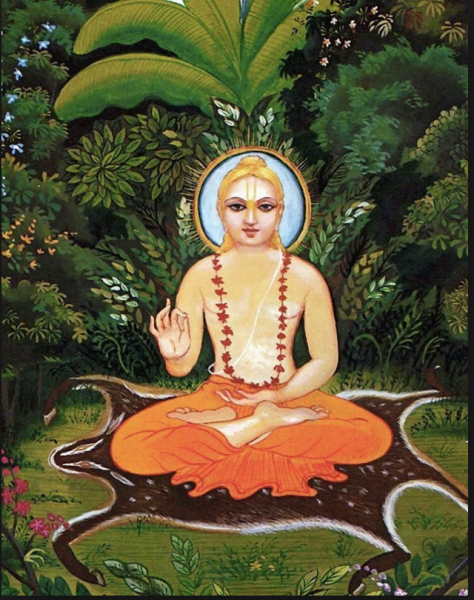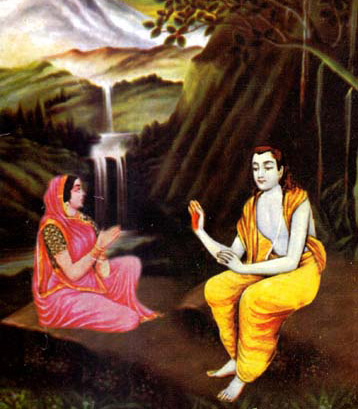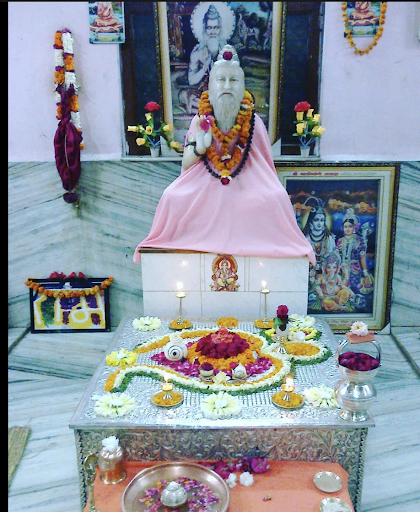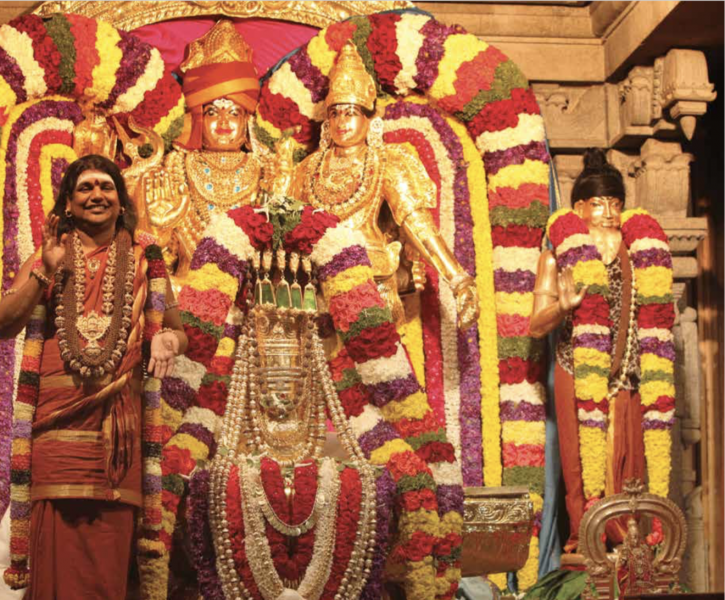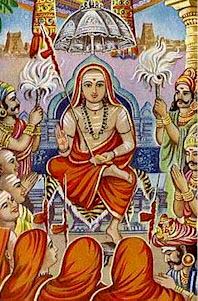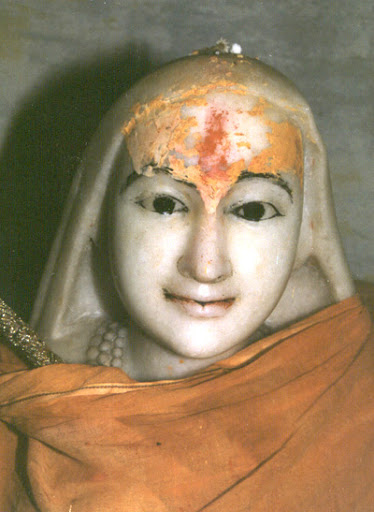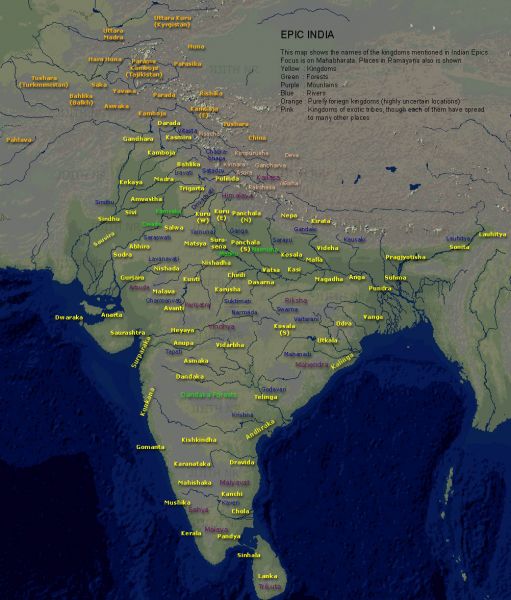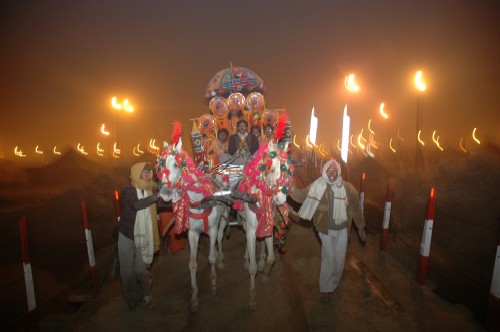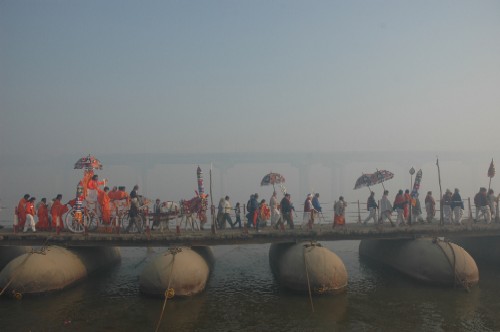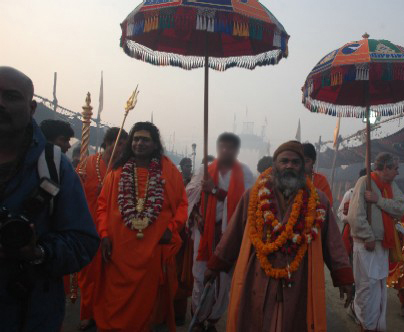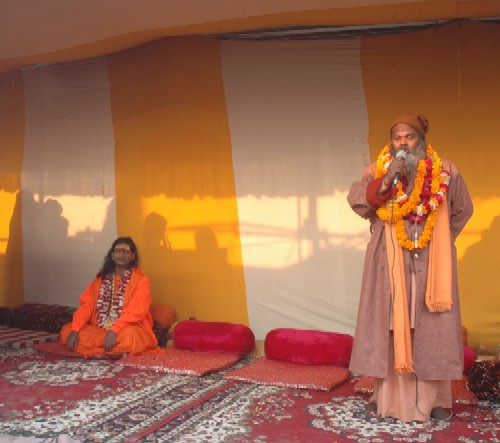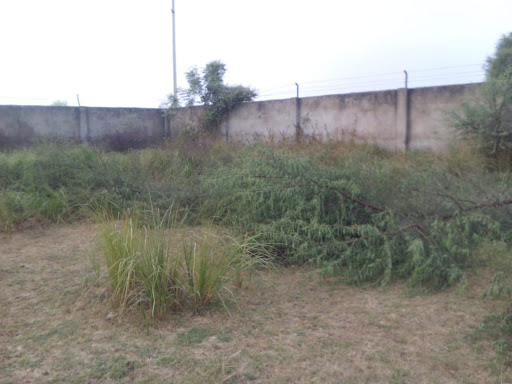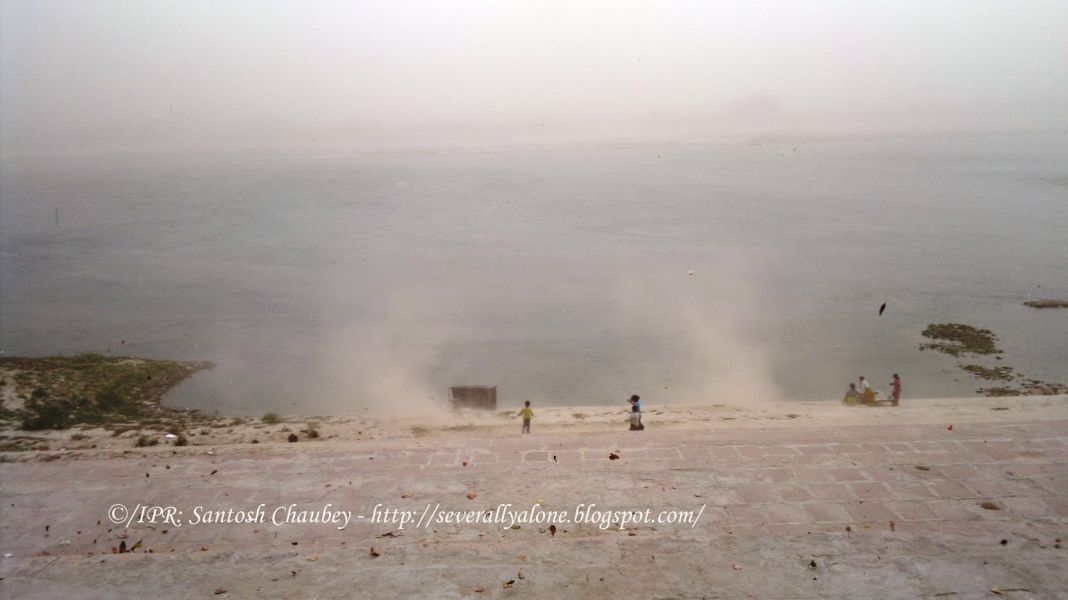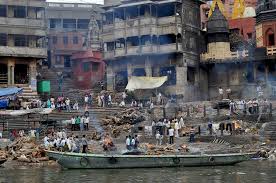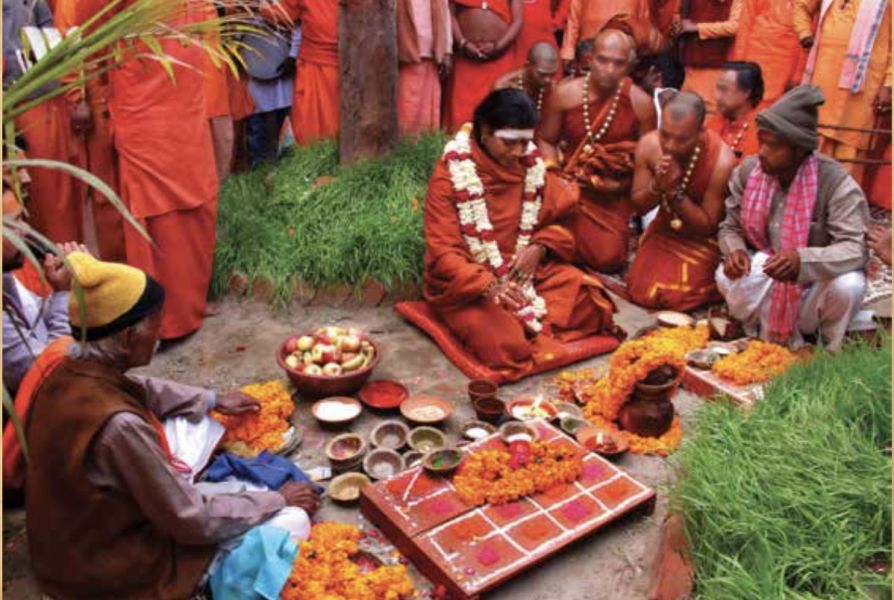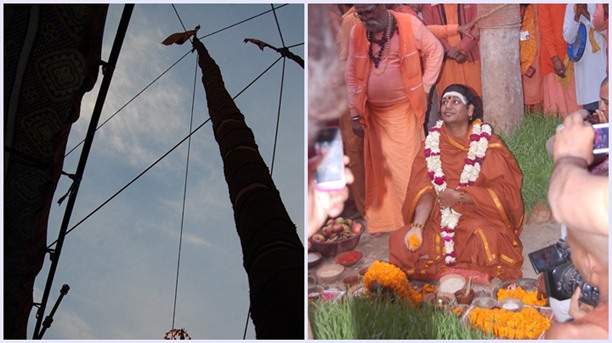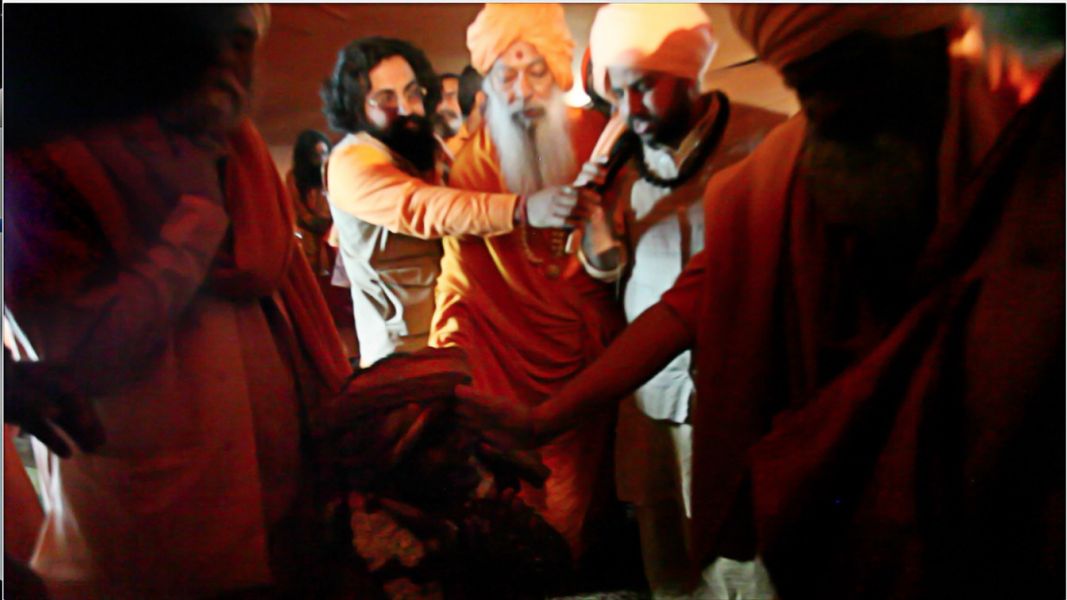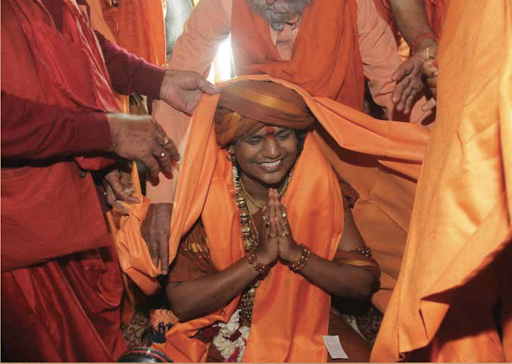Difference between revisions of "Kailaasa Paramparagatha Mahanirvani Peetham"
| Line 230: | Line 230: | ||
<gallery mode=packed heights=400px> | <gallery mode=packed heights=400px> | ||
| − | File: | + | File:mahamandaleshvar.jpg|alt=see caption|The Kingdoms of Ancient India (pre-British invasions) |
File:KMprocession.jpg|alt=see caption| | File:KMprocession.jpg|alt=see caption| | ||
Revision as of 06:55, 21 October 2019
The Daiva Paramparā (Divine Lineage)
Bhagavan Sri Paramaśiva
Paramaśiva, the Cosmic Source and ultimate Divinity, started the lineage of Akhāḍās with the ascetic warriors (Nāgā Sādhus) along with His direct disciples and descendants - called the Paramaśiva Ganas. ( https://www.wisdomlib.org/definition/paramashiva;)
It is from Bhagavan Sri Paramaśiva, the Primordial Source, came forth the most ancient living lineage of ĀdiŚaiva traditions and sanyas (monkhood) called ‘Akhāḍās’ of ascetic warriors who defend the land and Dharma (the Cosmic law). Paramaśiva came down to the sacred city of Varanasi in North India with his empowered direct disciples (Śiva ganas) and sons Śrī Kumara and Śrī Gaṇeśa (king of Gaṇas, followers of Paramaśiva) and established the eternal unbroken spiritual flow of ascetics, forming the first Akhāḍā.
The Original Akhāḍā Structure
Daksha (Son of Lord Brahma) was called Daksha Prajapati as he functioned as the President of humanity during his times. He delivered the Daksha Smṛti - The Do's and Dont's - for Humanity. He organised a massive Yaga (sacrificial fire) for which he deliberately avoided calling his daughter Sati and Her Divine Consort Paramaśiva Himself. When Sati, pulled by parental bonding, went by herself to the Yaga, Daksha further insulted her in front of the entire gathering. Sati unable to withstand the insult of her own father, self-immolated herself in the sacrificial fire. News reached Paramaśiva, who invoked Vīrabhadra to slay Daksha's head.
Daksha fell low in the eyes of all after this incident. The Sapta Rishis refused to henceforth follow Daksha Smṛti as they saw that Daksha was no more integrated to Paramaśiva, (Primordial Hindu Divinity). They requested Paramaśiva to reveal the guidelines yet again to them so they can follow. The sacred spot where Paramaśiva revealed the Agamas to them, is the Daksheshwar temple of Mayapur in Haridwar, where the Kailaasa Paramparagatha Mahanirvani Peetham (spiritual and religious kingdom) is headquartered. Even from during the times of Daksha, this temple was the headquarters of the Peetha.
After revealing the Agamas, Paramaśiva appointed Sage Kapila as the Head of the Mahanirvani Peetha, thus establishing the Mahanirvani Peetha.
Thus, Bhagavān Sri Paramaśiva, the ultimate Divinity, institutionalized the constitution, administration and protection for this enlightened ecosystem on the planet by establishing the ‘Akhāḍās’ (traditions within Hinduism) with His direct disciples and descendants called the Paramaśiva Gaṇas and warrior ascetics (Nāgās) from Varanasi, the most ancient living city of earth. Under His divine ordainment, the spiritual, religious, historical, political, economic and social ecosystems were formally established. (Ref.: https://en.wikipedia.org/wiki/Akhara).
Lord Śrī Kapila Mahāmuni, the organizer of Akhāḍās - glory and lineage linking Manu, Daksha, Kapila and Dattatreya
Incarnation of Paramaśiva and Lord Viṣṇu, from the Sūrya vaṁśa, the Sun dynasty
Lord Śri Kapila Mahāmuni is the incarnation of Lord Śrī Paramaśiva and Lord Viṣṇu, who appeared in the Sūrya vaṁśa, the sun-dynasty as the son of glorious Prajāpati Kardama, one of the nine sons of Lord Brahma and procreator of human life on planet earth and as the son of Devāhuti, the daughter of the reigning Manu Svayambhuva (the lord of the first manvantara or aeon) the original ancestor of the Sūrya vaṃśa, the Sun Dynasty.
Srimad Bhagavat Purāṇa, the Hindu scripture (purāṇas are scriptures that record the historical happenings of cosmos, of cosmic laws (dharma), of all incarnations) gives detailed accounts about Śrī Kapila’s divine lineage and His purpose:
Lord Kapila Mahāmuni is an Incarnation
वेदाहमाद्यं पुरुषमवतीर्णं स्वमायया भूतानां शेवधिं देहं बिभ्राणं कपिलं मुने ॥ ३.२४.१६ ॥
vedāham ādyaṁ puruṣam avatīrṇaṁ sva-māyayā | bhūtānāṁ śevadhiṁ dehaṁ bibhrāṇaṁ kapilaṁ mune ||
- Śrimad Bhāgavatam 3.24.16
Translation: Lord Brahma said to his son Kardama - Kardama, I know that the original Divinity has now appeared as an incarnation by His internal energy. He is the bestower of all that is desired by the living entities, and He has now assumed the body of Kapila Muni.
Lord Kapila Mahāmuni transmitted the ultimate enlightenment sciences, Jnana-Vijnana Yoga
ज्ञानविज्ञानयोगेन कर्मणामुद्धरन्जटाः हिरण्यकेशः पद्माक्षः पद्ममुद्रापदाम्बुजः ॥ ३.२४.१७ ॥
Jñāna-vijñāna-yogena karmaṇām uddharan jaṭāḥ hiraṇya-keśaḥ padmākṣaḥ padma-mudrā-padāmbujaḥ ||
- Śrimad Bhāgavatam 3.24.19
Translation: Lord Brahmā said, “By ultimate yoga of Jñāna, the pure knowledge of enlightenment and vijñāna, transmitting the realization of enlightenment sciences as ordained in the scriptures, Kapila Muni, who is characterized by His golden hair, His eyes just like lotus petals and His lotus feet, which bear the marks of lotus flowers, will uproot the deep-rooted desire for work in this material world.”
Manu’s daughters are Devahuti and Prasūti
मैत्रेय उवाच । मनोस्तु शतरूपायां तिस्रः कन्याश्च जज्ञिरे आकूतिर्देवहूतिश्च प्रसूतिरिति विश्रुताः ॥ ४.१.१ ॥
maitreya uvāca manos tu śatarūpāyāṁ tisraḥ kanyāś ca jajñire ākūtir devahūtiś ca prasūtir iti viśrutāḥ
- Śrimad Bhāgavatam 4.1.1
Translation: Śrī Maitreya said: Svāyambhuva Manu begot three daughters in his wife, Śatarūpā, and their names were Ākūti, Devahūti and Prasūti.
Daksha’s wife is Prasūti (establishing Daksha in the lineage of Manu)
दक्षाय ब्रह्मपुत्राय प्रसूतिं भगवान्मनुः प्रायच्छद्यत्कृतः सर्गस्त्रिलोक्यां विततो महान् ॥ ४.१.११ ॥
dakṣāya brahma-putrāya prasūtiṁ bhagavān manuḥ prāyacchad yat-kṛtaḥ sargas tri-lokyāṁ vitato mahān
- Śrimad Bhāgavatam 4.1.11
Translation: Svāyambhuva Manu handed over his daughter Prasūti to the son of Brahmā named Dakṣa, who was also one of the progenitors of the living entities. The descendants of Dakṣa are spread throughout the three worlds. Svāyambhuva Manu handed over his daughter Prasūti to the son of Brahmā named Dakṣa, who was also one of the progenitors of the living entities. The descendants of Dakṣa are spread throughout the three worlds.
Anasūya (mother of Lord Dattatreya) is daughter of Prajapati Kardama Muni & Devahuti (and sister of Bhagavan Kapila Mahamuni as per verses 3.24.18-19)
याः कर्दमसुताः प्रोक्ता नव ब्रह्मर्षिपत्नयः तासां प्रसूतिप्रसवं प्रोच्यमानं निबोध मे ॥ ४.१.१२ ॥
yāḥ kardama-sutāḥ proktā. nava brahmarṣi-patnayaḥ tāsāṁ prasūti-prasavaṁ procyamānaṁ nibodha me
- Śrimad Bhāgavatam 4.1.12
Translation: You have already been informed about the nine daughters of Kardama Muni and Devāhuti, who were handed over in marriage to nine different Brahmarṣi, Pure Enlightened Sages (namely Marīci, Atri, Aṅgirā, Pulastya, Pulaha, Kratu, Bhṛgu, Vasiṣṭha and Atharvā.. I shall now describe the descendants of those nine daughters (Kala, Anasūyā, Sraddha, Havirbhu, Gitā, Kriya, Khyāti, Arundhati and Shanti)
Anasūyā is the Mother of Bhagavan Dattatreya, the Incarnation (establishing Dattatreya in the lineage of Manu)
अत्रेः पत्न्यनसूया त्रीञ्जज्ञे सुयशसः सुतान् दत्तं दुर्वाससं सोममात्मेशब्रह्मसम्भवान् ॥ ४.१.१५ ॥
atreḥ patny anasūyā trīñ jajñe suyaśasaḥ sutān dattaṁ durvāsasaṁ somam ātmeśa-brahma-sambhavān
- Śrimad Bhāgavatam 4.1.15
Translation: Anasūyā, the wife of Atri Muni, gave birth to three very famous sons — Soma, Dattātreya and Durvāsā — who were partial representations of Lord Viṣṇu, Lord Śiva and Lord Brahmā. Soma was a partial representation of Lord Brahmā, Dattātreya was a partial representation of Lord Viṣṇu, and Durvāsā was a partial representation of Lord Śiva.
Devāhuti, the daughter of the Sūrya Vaṃsa (Sun dynasty’s) original Manu, is mother of Lord Kapila. Lord Kapila Mahāmuni is the Siddhagaṇadhīśa, the emperor of perfected beings (establishing Kapila in the lineage of Manu)
एष मानवि ते गर्भं प्रविष्टः कैटभार्दनः अविद्यासंशयग्रन्थिं छित्त्वा गां विचरिष्यति ॥ ३.२४.१८ ॥
eṣa mānavi te garbhaṁ praviṣṭaḥ kaiṭabhārdanaḥ avidyā-saṁśaya-granthiṁ chittvā gāṁ vicariṣyati
अयं सिद्धगणाधीशः साङ्ख्याचार्यैः सुसम्मतः लोके कपिल इत्याख्यां गन्ता ते कीर्तिवर्धनः ॥ ३.२४.१९ ॥
ayaṁ siddha-gaṇādhīśaḥ sāṅkhyācāryaiḥ susammataḥ loke kapila ity ākhyāṁ gantā te kīrti-vardhanaḥ
- Śrimad Bhāgavatam 3.24.18-19
Translation: Lord Brahmā then told Devahūti: My dear daughter of Manu, the same Absolute Lord who killed the demon Kaiṭabha is now within your womb. He will cut off all the knots of your ignorance and doubt. Then He will travel all over the world. “Your son will be the emperor of all the perfected being, Siddhagaṇadhīśa. He will be approved by the Acāryas, the spiritual authorities, experts in transmitting the real absolute knowledge, and among the people He will be gloriously celebrated by the name Kapila. As the son of Devahūti, He will increase your fame.”
About 20,000 years back, Śrī Kapila Mahāmuni brought forth the “Science of pure thought currents to humanity called Sānkhya Darśana’’ initiating a revealing this science first to his mother Devahuti. Sānkhya is the naked philosophy of the Truth. Śrī Kapila Mahāmuni lived in Varanasi, who further formed and organized the Akhāḍās, which became the foundation for all other Akhāḍās. Many of the shāstradhāris (the ascetic warriors bearing revealed scriptures) of the Akhāḍās, carried their bodies with spiritual purity and freedom. (Ref.: https://en.wikipedia.org/wiki/Kapila)
Thus was born the naked Nāgā Sādhus of the Mahānirvaṇi Akhāḍā. Śrī Kapila also created the Dasanāmi Sampradāya – the tradition of 10 Sanyāsa names given to various Sanyāsis of the Akhāḍā. द॒शा॒नामेकं॑ कपि॒लं (daśonāmekam kapilam) – meaning among 10 divine names is “Kapila” – says Rig Veda 10/27. (Rig Veda is one of the four main Vedas, the revealed source scriptures in Hinduism) (Ref.: https://en.wikipedia.org/wiki/Mahanirvani_Akhara)
Kapila created the tradition of the Kumbh Mela – the ultimate celebration of freedom from the bondage of the world. Kumbh Mela is to date the world’s largest gathering of spiritual people. One of the main responsibilities of the Akhāḍās is teaching and transmitting the great teachings of Shāstras (revealed scriptures from Paramaśiva). Thus the ascetic monks (Nāgās) are called Shāstradharis in Sanskrit. They also use Śastra (weapons) to protect the sacred traditions from external negative forces. Wielding of both Śāstra and Śastra within the scope of the Dharma (Cosmic Law) is the main responsibility of the Akhāḍās.
For tens of thousand of years both the Shāstradharis (bearers of scriptures - the intelligentsia) and the Shastradhaaris (bearers of weapons) would meet, celebrate and uphold the spiritual teachings. Even today the Kumbh Mela begins with the immersion of the urn (kumbh) containing Kapila’s skull into the sacred waters of the Prayag (confluence of the three sacred rivers namely Ganga, Yamuna and Saraswati). In his memory and living presence the followers of Hinduism celebrate every twelves year, the liberation that is enlightenment – Nirvāṇa. (Ref.: https://en.wikipedia.org/wiki/Varanasi) Śrī Kapila Mahāmuni is also named as ‘Sākhya Muni’ or ‘Sānkhya Muni’. The Buddha, in the lineage of Mahānirvani Akhāḍā also came to be known as the ‘Sākhya Muni’.
Śrī Ādi Śankarācārya - The Reviver and Organizer of the Akhāḍās
Sri Ādi Śankarācārya is an incarnation of Paramaśiva, who descended in the 8th century. He organised and unified the main thought currents (Truth threads) that exist within Sanātana Hindu Dharma, in the form of various traditions or Sampradāyas called Akhāḍās. He is the organizer and reviver of the Dashanami Sampradāya (the monastic tradition), organizing a section of the Ēkadaṇḍi monastics under an umbrella grouping of ten names (‘daśa’ meaning ten, ‘nām’ meaning name in Sanskrit). He also revived and organized the Mahanirvani Akhāḍā. He formally organized it in 748 C.E constituting a democratic structure giving stability and legitimacy to Hinduism’s core spiritual traditions (sampradāya) in the form of the Akhāḍās or Apex bodies of Hinduism. (Ref.: https://en.wikipedia.org/wiki/Adi_Shankara )
The Ekadandi Sanyāsis (wandering renunciates and monks bearing a single staff) were organised into ten sects or names (daśanāma), which fell under four Mathas or monasteries under the sacred system entirely based on the guru-disciple tradition, where the lineage of each sect was maintained and inherited from Guru to disciple. (Ref.: https://en.wikipedia.org/wiki/Dashanami_Sampradaya#%C4%92kada%E1%B9%87%E1%B8%8Dis
In Sanātana Hindu Dharma (Hinduism), all knowledge and traditions are traced back to the original source, which is Śrī Paramaśiva. The Guru-parampara (Guru’s lineage) begins with Paramaśiva as the primordial Guru, who descends as the Incarnation from time to time to transmit, preserve and protect the science of enlightenment to His disciples and to humanity. This is the Daiva-Paramparā, which is followed by the Rishi-Parampara, where the enlightened seers were able to transmit the direct words of Paramaśiva to the next generation of seekers. Finally, comes the Mānava-Paramparā, where the disciples who received this knowledge maintain and uphold the tradition from one generation to the next.
Background of the Mahanirvani Akhada
Akhāḍās form the core body of the Hindu tradition, they are the oldest and largest Apex body of Hinduism. As of now at least 1 million Sādhus (saints) are dedicated and live under the Akhada Parishad, which is the apex council body of Hinduism with a democratic selection structure of its spiritual leaders, where all the fourteen Akhadas are members.
14 Akhāḍās are accepted widely, as main stream Akhāḍās, but there are many minor Akhāḍās affiliated to these, which function as the sister organizations or subsidiaries, carrying ideological connection yet having their independent identity.
Varanasi or Kashi was the spiritual headquarters of Kailaasa Paramparagatha Mahanirvani Peetham where Sri Kapila Mahāmuni’s Māhā Jīvasamādhi (final enlightened resting place) is located. Haridwar is the current spiritual headquarters
Incarnations in the lineage of MahaNirvani Akhada
BHAGAVĀN ŚRĪ KṚṢNA (22nd Incarnation or Avatār)
The most celebrated and revered, complete incarnation Bhagavan Sri Kṛṣna belongs to the lineage of the Mahanirvani Akhada. Over 5000 years ago, Sri Kṛṣna, in His ultimate teachings in Sri Bhagavad Gita, reveals - ‘सिद्धानां कपिलो मुनि: - siddhānām kapilomuniḥ - of the perfect complete beings, I am Kapila.” (Bhagavad Gītā,10.26), expressing deep gratitude to his lineage.
Śrī Kṛṣna and his brother Śrī Balarāma went to the Hindu school (gurukul) in Ujjaini, North India in a sacred place called the Sandipani Ashram – which was the major center of learning of the Mahanirvani Akhada. After Haridwar and Prayag, the Mahanirvani Akhada spread around the country and during the divine kingdom and reign of Bhagavan Śrī Kṛṣna, Ujjain was one of the most important centers.
GAUTAMA BUDDHA (23rd Incarnation or Avatār)
The Incarnation of Buddha (Siddharth), also comes from the lineage of Mahanirvani Akhada. He took the sacred vows of Sanyāsa (monkhood) at Kailaasa Paramparagatha Mahanirvani Peetham.
There are 52 Madhis or branches in Mahanirvani, one of which is Buddhism. The initiated followers of the Buddha receive the respect and recognition as one of the Madhi (branch) of Nirvani Akhada.
Life of the Nāgā Sādhus (Ascetic Warriors)
The life of the naga sadhus is one of courage, freedom and extraordinary discipline. Nāgā sādhus have powerful bodies that can tolerate extremes of temperature. Their only protection against cold is the vibhuti (sacred ash) they apply freely all over the body and their spiritual powers.
Most Nāgā sādhus wear rudrakshmāla (sacred energy beads) and an iron bracelet (kada), and carry a damroo (a small drum) and a kamanḍalu (water pot). Their only other adornments are weapons of defense, which are part of the akhāḍā culture and are worshipped every day.
Nāgā sādhus can be identified by their holy trishul (Śiva’ trident), staff, sword, conch and other musical instruments.
Madhis or Temple Centers - Forerunner of the Akhāḍas
As the Nāgā Sādhus grew in number to tens of thousands, they began forming groups known as ‘madhis’.
All the saints of various madhis in one geographical location would gather together to do arms training (shastra-training) without any differences. Since various madhis were working together as one group, this group was called ‘akhanḍa’ or ‘united’, a term which became ‘Akhāḍā’. The first Akhāḍā to be established was the Atal Akhada, followed by the Awahan Akhada and Mahanirvani Akhada. Today, there are 14 Akhāḍās in Haridwar, each of them headed by a highly revered Ācārya Mahāmanḍaleśvar, who is supported by a number of Mahāmanḍaleśvars.
Mahanirvani Akhada Administration
The spiritual head of Mahanirvani Akhada is known as Ācārya Mahāmanḍaleśvar. He is elected by the Mahāmanḍaleśvars of the Akhāḍā, and his is a lifetime position and responsibility. Currently, the Mahanirvani Akhada has 46 Mahāmanḍaleśvars (spiritual pontiffs). Apart from this, there are administrative positions like Sachiv (secretary), Sri Mahant, Mahant, Karobari / Kothari and Thanapati / Thanedar.
The top administrative body of the Akhāḍā is Shree Panch (the body of five) also known as Pancheshwar, representing Brahma, Viṣṇu, Śiva, Shakti and Gaṇeśa. This body is usually elected every Kumbh Mela by a unanimous decision of senior Akhāḍā members.
The Mahanirvani Akhada as the direct representative of the presiding deity of Sri Paramaśiva governed the whole of Indian kingdom from North to South, East to West with its great ancient kingdoms starting from the Himalayas, the Kuru dynasties at Hastinapura (present day Delhi, India), Kashi, Panchala, Gaya, Magadha, Pundra (Bengal, East), Ayodhya, Kalinga (Orissa), Vidharba, Mallarastra (Maharastra, Central India), Avanti (Ujjain) to Southern kingdoms such as Kanchi, Lanka, to Saurashtra, Dwaraka in the West India.
Coronation of HDH Bhagavan Sri Nithyanandam Paramashivam
Recognized in 2007 as the successor spiritual leader of the Mahanirvani Akhada, HDH Sri Nithyananda Paramashivam was declared and coronated by the official leadership of the Sri Panchayati Akhada Mahanirvani as the “1008th Mahāmanḍaleśvar ”. In the 2007 Kumbh Mela at Allahahad (Prayag) in North India, HDH was honored with the royal chariot of the Kailaasa Paramparagatha Mahanirvani Peetham as the Mahāmanḍaleśvar , and enthroned on it, He led the sacred procession of all the 14 Akhadas to the Triveni Sangamam (Confluence of the three sacred rivers) where He took the first dip - Shahi Snan (Royal Bath) and following Him the remaining akhadas and millions of people dipped in the sacred confluence.
Through a process of democratic selection amongst the 43 Mahāmanḍaleśvars of all the 14 Akhāḍās, He was unanimously elected as the 1008th Mahāmanḍaleśvar of Sri Panchayati Akhada Mahanirvani. This was a monumental rare honor in the history of all 14 Akhāḍās of the Indian Kingdom, having one of the youngest spiritual leaders to receive the title and responsibility thereof, as the Mahāmanḍaleśvar for the kingdom of India.
The 14 Akhāḍās are namely -
1. Sri Panchayati Akhada Mahanirvani
2. Sri Pancha Atal Akhada -Varanasi
3. Sri Panchayati Akhada Niranjani - Prayag
4. Taponidhi Sri Anand Akhada Panchayati - Nasik
5. Sri Panchadashnaam Juna Akhara -Varanasi
6. Sri Panchadashnaam Aavahan Akhada -Varanasi
7. Sri Panchadashnaam Panchagni Akhada -Junagadh
8. Sri Digambar Ani Akhara -Sabarkantha
9. Sri Nirvani Ani Akhada -Ayodhya
10. Sri Nirmohi Ani Akhada -Mathura
11. Nirmal Ani
12, Sri Panchayati Bada Udaseen Akhada -Allahabad
13. Sri Panchayati Akhada Naya Udaseen -Haridwar
14. Sri Nirmal Panchayati Akhada -Haridwar
After the coronation, the Akhāḍās gifted the sacred properties to His Divine Holiness
As a mark of spiritual successorship to the divine kingdom of India, the Akhāḍās gifted HDH Bhagavan Sri Nithyananda Paramashivam with sacred properties of high spiritual heritage.
Sooltankeshwar, near Varanasi is an ancient sacred place where Lord Paramaśiva impressed and installed His divine weapon called ‘shoola’ into the earth. Hindu scriptures reveal that the ancient Varanasi city rests of the divine ‘shoola’ (the trident) of Lord Paramaśiva, and thus is indestructible and eternal city of the Lord.
Manikarnika Ghat, Varanasi property was gifted to the previous ruling Atal Akhada Ācārya Peethadheeshwar, Hon. late Sri Sukhdevanandji, who in turn gifted it to the current Ācārya HDH Bhagavan Sri Nithyananda Paramashivam. Manikarnika Ghat is the ultimate space where death becomes liberation and celebration, where the fire at the burning ghats has been lit from ancient times.
On 12 Feb 2013, His Divine Holiness was declared and coronated as the Successor Ācārya Mahāmanḍaleśvar of the Kailaasa Paramparagatha Mahanirvani Peetham.
- Akhadacoronation4.jpeg
- Akhadacoronation5.jpeg
Senior Swamis, Ācāryas and Maha Mandaleshwars of Nirvani Akhada offer their love and adoration to HDH on the auspicious occasion
